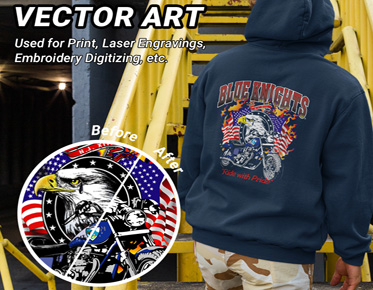Solving Design Dilemmas: Addressing Client Needs Through Embroidery Digitizing
Introduction
Embroidery digitizing in USA has revolutionized the way designers and embroiderers approach their craft. It's not just about stitching anymore; it's about translating intricate designs into digital formats that embroidery machines can interpret and replicate with precision. In this article, we'll explore how embroidery digitizing allows designers to address various client needs, from branding to customization, and how it helps overcome design dilemmas to deliver exceptional results.
Understanding Client Requirements
● Importance of Client
Communication: Effective communication is the
cornerstone of successful embroidery digitizing projects. By actively listening
to clients and asking the right questions, designers can gain valuable insights
into their preferences, expectations, and brand identity. Whether it's a
corporate logo or a custom design for personal apparel, understanding the
client's vision is crucial for delivering satisfactory results.
● Gathering Design Briefs: Design briefs serve as roadmaps for embroidery digitizing projects. They outline key details such as color schemes, design elements, size specifications, and intended applications. By collecting comprehensive design briefs from clients, designers can ensure that their digitized designs align perfectly with client expectations and project requirements.
Assessing Design Challenges
● Analyzing Design Constraints:
Every design comes with its unique set of challenges.
Whether it's intricate details that need to be preserved or color limitations
imposed by the embroidery process, designers must carefully assess these
constraints to develop effective digitizing strategies. By identifying
potential pitfalls early on, designers can proactively address them and avoid
costly mistakes down the line.
● Evaluating Technical Feasibility: While clients may have grand visions for their embroidered designs, not all ideas are technically feasible. Designers must evaluate the technical feasibility of translating complex designs into embroidery format. Factors such as stitch density, thread type, and machine compatibility play crucial roles in determining the feasibility of a design. By conducting thorough assessments, designers can manage client expectations and ensure realistic outcomes.
Selecting Digitizing Techniques
● Exploring Digitizing Methods:
Embroidery digitizing offers a range of techniques,
from manual digitizing to auto-digitizing and applique. Each method has its
strengths and limitations, and designers must choose the most suitable approach
based on design complexity, stitch count, and client preferences. By
understanding the nuances of each digitizing technique, designers can deliver
high-quality results that meet client expectations.
● Tailoring Techniques to Design Needs: One size doesn't fit all when it comes to embroidery digitizing techniques. Designers must tailor their digitizing methods to match the intricacies of each design. Whether it's fine details that require manual digitizing or simple logos that can be auto-digitized, designers must adapt their techniques to ensure optimal results. By customizing their approach, designers can enhance the quality and visual appeal of their digitized designs.
Customizing Designs to Client
Preferences
● Incorporating Branding
Elements: For corporate clients, branding consistency
is paramount. Designers must incorporate client branding elements such as
logos, fonts, and color palettes into their digitized designs. By adhering to
brand guidelines and specifications, designers can ensure that their
embroidered products accurately reflect the client's brand identity and
messaging.
● Accommodating Design
Revisions: Client feedback is an integral part of the
design process. Designers must be receptive to client input and accommodate
design revisions as needed. Whether it's adjusting colors, tweaking design
elements, or resizing the embroidery, designers must work collaboratively with
clients to fine-tune their designs. By fostering open communication and
flexibility, designers can ensure client satisfaction and project success.
Enhancing Design Aesthetics
● Adding Dimension and Texture:
Embroidery isn't just about flat stitches anymore.
Designers can add depth and texture to their digitized designs by incorporating
techniques such as 3D puff embroidery, raised
stitching, and textured fills. These techniques create visually captivating
designs that stand out from the crowd and provide a tactile experience for the
viewer.
● Experimenting with Stitch Variations: The choice of stitches can dramatically impact the look and feel of an embroidered design. Designers can experiment with different stitch types, densities, and patterns to achieve various textures and effects. Whether it's satin stitches for smooth surfaces or fill stitches for intricate details, designers have a wide range of options at their disposal to bring their designs to life.
Optimizing Design Placement and Scaling
● Considering Product
Application: Where the embroidery goes is just as
important as how it looks. Designers must consider factors such as fabric type,
garment structure, and intended usage when placing their designs. Whether it's
a small logo on a shirt pocket or a large design on the back of a jacket,
designers must ensure that their embroidery is positioned for maximum visual
impact and wearer comfort.
● Scaling Designs for
Versatility: A one-size-fits-all approach doesn't work
in embroidery. Designers must scale their designs to fit various product
dimensions and placement areas. By offering versatility in design sizes and
proportions, designers can cater to various products and applications, from
apparel and accessories to promotional merchandise and corporate gifts.
Addressing Production Considerations
● Collaborating with Production
Partners: Embroidery doesn't end with digitizing; it's
just the beginning of the production process. Designers must collaborate
closely with production teams and manufacturers to ensure seamless integration
of their digitized designs into the production workflow. By working
hand-in-hand with production partners, designers can address any technical
challenges or requirements and ensure high-quality results.
● Adhering to Technical
Specifications: Every embroidery machine has its
quirks and preferences. Designers must adhere to technical specifications such
as thread colors, stitch counts, and machine compatibility to ensure smooth
production. By following industry standards and guidelines, designers can
minimize errors and discrepancies and deliver production-ready embroidery
files.
Managing Time and Budget
Constraints
● Establishing Realistic
Timelines: Time is of the essence in embroidery
projects. Designers must establish realistic timelines and milestones that account
for design complexities, revisions, and production lead times. By managing
expectations and setting clear deadlines, designers can ensure the timely
delivery of embroidered products and maintain client satisfaction.
● Budget-Friendly Solutions: Quality doesn't have to break the bank. Designers must offer
budget-friendly digitizing solutions that align with client budgets without
compromising on quality. Whether it's optimizing stitch counts, simplifying
design elements, or leveraging efficient production methods, designers can find
creative ways to deliver high-value embroidery within budget constraints.
Presenting Final Designs and
Solutions
● Providing Design Mockups: Seeing is believing. Designers must present clients with realistic
design mockups and proofs that accurately depict how the final embroidery will
look. By providing visual representations of their designs, designers can
solicit client feedback and approval before proceeding with production.
● Offering Value-Added
Services: Embroidery is more than just stitching; it's
about creating memorable experiences for clients. Designers can offer
value-added services such as design consultations, sample production, and
embroidery tutorials to enhance the overall client experience. By going above
and beyond, designers can build lasting relationships with clients and position
themselves as trusted partners in the embroidery industry.
Eagle Digitizing Services: A
Solution for Clients
Eagle Digitizing stands out as a premier
provider of online embroidery digitizing
services, offering unparalleled expertise and commitment to quality. With a
comprehensive range of services including custom digitizing, vector conversion,
and 3D puff digitizing, Eagle Digitizing caters to diverse client needs with
precision and excellence.
Collaboration and Continued Improvement
Ongoing collaboration between clients and
digitizing experts is key to driving innovation and excellence in embroidery
digitizing. Feedback loops and continuous improvement processes enable
designers to refine their techniques and deliver superior results with each
project. Embracing creativity and embracing change ensures that designers stay
ahead of the curve in addressing future design dilemmas.
Conclusion
Embroidery digitizing is a powerful tool for
addressing design dilemmas and meeting client needs in the ever-evolving world
of embroidery. By understanding client requirements, selecting appropriate
digitizing techniques, and delivering exceptional results, designers can ensure
client satisfaction and success in their embroidery projects. With Eagle
Digitizing's reliable services and expertise, clients can trust that their
digitizing needs will be met with professionalism and quality craftsmanship.
Ready to elevate your embroiderydesigns? Contact Eagle Digitizing today to explore our
comprehensive range of digitizing services and take your designs to the next
level!



